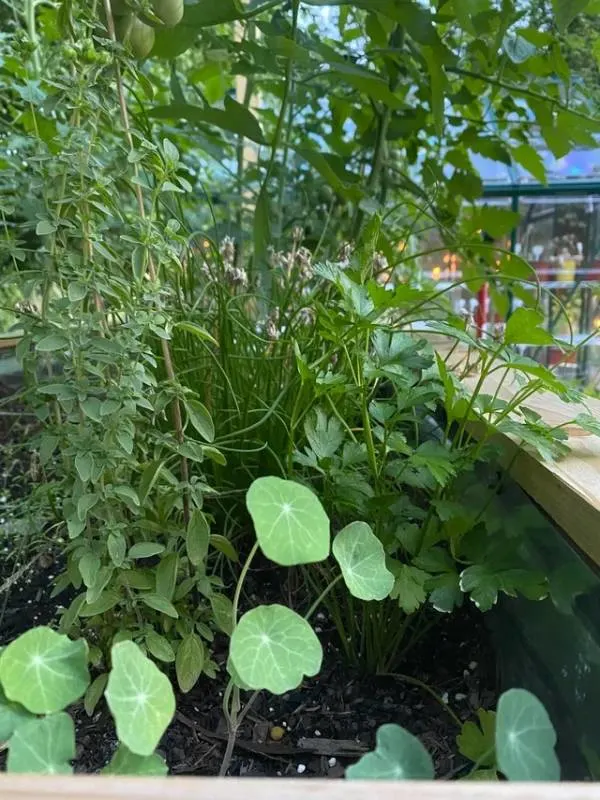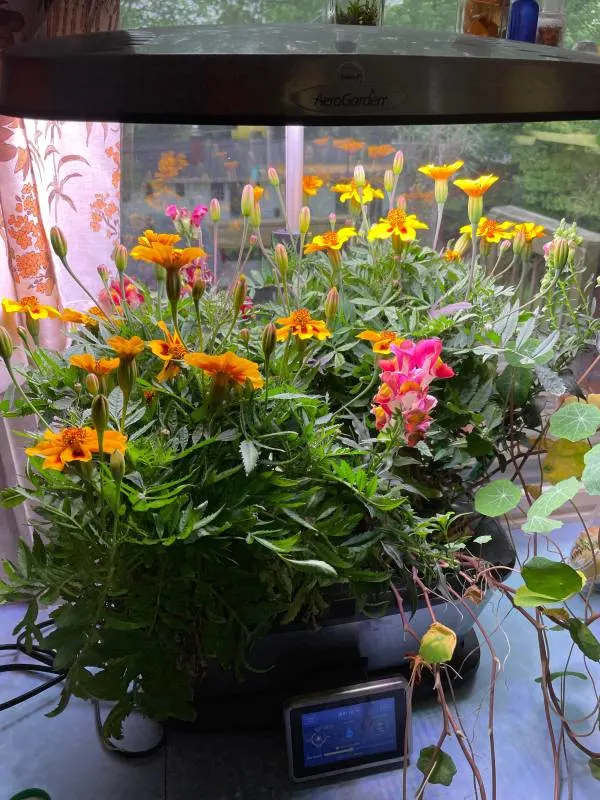Gardening enthusiasts often seek the perfect harmony between different plants, aiming for an aesthetically pleasing and ecologically balanced garden.
With their vibrant blooms and easy-going nature, nasturtium plants are a popular choice for many vegetable gardens. However, the secret to maximizing their beauty and benefits lies in understanding the art of planting nasturtiums with its best companion plants.
This article delves into the ideal companions for nasturtiums, plants that not only coexist peacefully but also enhance each other’s growth and well-being.
Additionally, we’ll explore three plants that are not suitable companions, helping you avoid common gardening pitfalls.

Nasturtium- A Brief Overview
Nasturtiums, scientifically known as Tropaeolum majus, are notable for their vibrant, trumpet-shaped flowers and circular, shield-like leaves.
Originating from South and Central America, these plants are cherished in gardens worldwide for their bright blooms in shades of red, orange, yellow, and cream. There are different varieties of nasturtium, from single-flower plants to double-flowers.
What sets nasturtiums apart is that it is an edible plant- from nasturtium seeds to edible flowers, leaves, and stems- offering a peppery flavor similar to watercress. Nasturtium seeds are large, round, and bumpy. They can be pickled and used as a substitute for capers. Unripe Nasturtium seeds are usually used for this purpose
They thrive in full sun with well-draining soil and are often used as ground cover or in hanging baskets due to their sprawling growth habit. They can be drought tolerant, too, and can grow anywhere.
Additionally, nasturtiums are known for their ability to attract beneficial insects and repel pests due to the chemicals they release throughout their growing season, making them a popular choice for companion planting in vegetable gardens.
Nasturtium as Companion Plants for A Vegetable Garden
Nasturtiums are highly valued in vegetable gardens for their role as companion plants, offering a range of benefits:
Pest Repellent: Nasturtiums are known as a natural pest control plant because they repel a variety of garden pests that commonly affect a vegetable garden. They are especially effective against aphids, whiteflies, cabbage worms, flea beetles, squash bugs, cabbage loopers, Japanese beetles, and cucumber beetles. Their strong scent and bright flowers act as a natural deterrent.
Trap Crop: They serve as trap crops, attracting pests like aphids and blackflies away from more vulnerable vegetables. This makes them an organic alternative to using chemical pesticides.
Attract Beneficial Insects: Nasturtiums attract beneficial insects like predatory insects, lacewings, and pollinators such as bees. These insects help control other pests and aid in pollinating vegetable plants, improving the garden’s overall health and productivity.
Improve Soil Quality: As a cover crop, nasturtiums can help reduce soil erosion and improve soil moisture retention in the garden. Their roots can also help aerate the soil.
Companion Planting Synergy: When planted near certain vegetables, nasturtiums can enhance growth and flavor. For example, they are known to improve the growth and flavor of cucumbers and radishes.
Natural Barrier: Their sprawling growth habit can create a physical barrier in the garden, helping to protect more delicate vegetables from wind or foot traffic.
Ideal Nasturtium Companion Plants
Fruit Trees
Fruit trees like apples and peaches serve as great companion plants for Nasturtiums in a vegetable garden, offering multiple benefits.
When you plant nasturtiums near apple trees, they act as natural pest deterrents, such as codling moths. Nasturtium’s vibrant flowers and lush foliage not only add aesthetic value but also play a crucial role in pest control.
Companion trees need full sun to thrive, while nasturtiums grow well in partial shade of these fruit trees. Also, these companion trees benefit nasturtium plants by shading the soil, holding the groundwater making the soil rich and moist.
The vibrant nasturtium flowers not only add aesthetic value to the garden but also attract pollinators, which are essential for the pollination of apple blossoms.
Furthermore, nasturtiums have a reputation for improving the growth and flavor of nearby plants, including apples. With their easy-to-grow nature and minimal care requirements, nasturtiums are a practical and beautiful addition to any apple orchard or vegetable garden.
This combination of fruit trees and nasturtium can be expanded by other plants, including wildflowers and alliums.
Brassica Plants
Brassica family, including broccoli, kale, collards, Brussels sprouts, and cabbage, are considered good companion plants for nasturtiums in gardens.
Growing nasturtiums alongside these vegetable crops offer significant benefits. Both nasturtium leaves and flowers are particularly effective in repelling common pests like cabbage worms, which are a frequent nuisance for Brassica plants while sometimes attracting aphids.
By companion planting nasturtiums with Brassicas, gardeners can naturally reduce the incidence of these pests, promoting healthier and more robust vegetable crops.
Planting nasturtium and Brassicas not only enhances the overall health of the garden but also encourages a more sustainable and organic approach to managing pests, making them an excellent choice for integrated pest control in a vegetable garden.
Potato, Peppers, and tomato plants

Companion planting nasturtiums with potatoes, peppers, and tomato plants is a strategic approach to enhance the overall health and productivity of a garden. Acting as a sacrificial crop, nasturtiums effectively repel aphids and other pests like the Colorado potato beetle, reducing the likelihood of infestation on the potato plants.
Adding nasturtiums can benefit nightshade plants like potatoes, tomato plants, and peppers as a ground cover. But sometimes, it can create problems for other plants, i.e., fruit trees that attract pests and cause diseases.
In return, these companion plants benefit the plant by enhancing the soil moisture by retaining water, breaking up the clay soil, and attracting pollinators.
Other crops like carrots, basil, and oregano as companion plants can grow well with nasturtiums.
Cucumber
The strategic pairing of growing nasturtiums with cucumbers in a vegetable garden setting creates a mutually beneficial relationship, enhancing the growth and flavor of both plants.
When cucumbers are planted alongside trailing nasturtiums, the cucumbers benefit from the pest-repellent properties of the nasturtiums. Nasturtiums are known to deter certain pests that might otherwise harm cucumber plants, like cucumber beetles, whiteflies, etc.
In return, the cucumbers aid the nasturtiums by providing partial shade, which is particularly beneficial in hot climates or during peak summer months. This shade helps maintain moisture and keeps the soil cool, preferred by nasturtiums.
Additionally, the spiky leaves and fruit of the cucumber plants can deter some pests, further protecting the nasturtiums and neighboring plants. The presence of both plants also attracts a variety of pollinators, ensuring better pollination and yield.
So, cucumber serves as a good companion plant for nasturtiums as it can lead to a healthier, more productive garden.
Marigold
Marigolds are renowned for their ability to repel nematodes; they produce a compound called alpha-terthienyl. This is a naturally occurring substance is particularly effective against these microscopic pests, which can cause significant damage to a wide range of garden plants.
Plant nasturtium with marigolds- this companion planting serves as a protective barrier, safeguarding the nasturtiums and neighboring plants from nematode infestations.

Cover Crops
Incorporating cover crops alongside nasturtiums in a garden setting can significantly enhance soil health and biodiversity. Cover crops, such as clover, legumes, or rye, play a vital role in soil enrichment by adding organic matter, improving soil structure, and increasing moisture retention.
The nasturtiums, with their vibrant blooms and lush foliage, attract beneficial insects and pollinators, which are essential for the overall health and productivity of the garden.
Meanwhile, the ground cover crops protect the soil, suppress weeds, and prevent soil erosion, creating a more hospitable environment for the nasturtiums to thrive.
This combination of growing nasturtium with cover crops not only enhances the aesthetic appeal of the garden but also promotes a sustainable and eco-friendly approach to gardening, emphasizing the importance of nurturing soil health and ecological balance.
Carrots and Raddish
Pairing carrots and radishes with nasturtiums in a garden setting offers a multitude of benefits for all involved plants.
Nasturtiums are an excellent trap crop, particularly against insects that might target root vegetables like carrots and radishes. Nasturtiums’ presence helps reduce the likelihood of pest infestations, promoting healthier growth in the carrot and radish plants.
In return, carrots, and radishes, with their different root depths and growth patterns, help to optimize soil utilization and reduce weed competition, creating a more favorable environment for the nasturtiums.
Additionally, the varied root systems of carrots and radishes can help to aerate the soil, benefiting the nasturtiums’ root health.
Wild Flowers
Nasturtium companion plants include wildflowers in flower beds that will create a dynamic and beneficial partnership. Their diverse shapes, colors, and blooming times contribute significantly to the biodiversity of the garden.
This diversity is key in attracting a wide range of beneficial insects, including pollinators and natural pest predators. Nasturtium flowers, known for their bright, trumpet-shaped, and peppery leaves, complement wildflowers by adding visual interest and attracting additional pollinators.
Furthermore, plant nasturtium acts as a trap crop with its distinctive scent, providing a natural form of pest control that benefits the surrounding wildflowers.
This interaction between wildflowers and nasturtiums not only creates a vibrant and aesthetically pleasing garden but also establishes a healthy ecosystem where plants support each other’s growth and resilience, demonstrating the power of companion planting in creating a flourishing and ecologically balanced garden space.
Which 3 Plants Are Not Suitable As Nasturtium Companions?
Nasturtiums, while generally cooperative in a companion planting setting, may not pair well with certain herbs such as sage, cilantro, and mint. Each of these herbs has specific reasons for not being ideal companions for nasturtiums:
Sage
Sage prefers a drier and more well-drained soil environment compared to the moist conditions favored by nasturtiums. The difference in water needs can make it challenging to maintain both plants in close proximity.
Moreover, sage, being a Mediterranean herb, thrives in less nutrient-rich soil, whereas nasturtiums do better in more fertile conditions. So do not grow nasturtiums with this herb.
Cilantro (Coriander)
Cilantro has a shorter growth cycle and prefers cooler temperatures than nasturtiums. Nasturtiums can grow quite large and may overshadow cilantro, impeding its growth and access to sunlight. Additionally, the water and nutrient needs of cilantro may not align well with those of nasturtiums.
Mint
Mint is not suitable as a nasturtium companion plant. It is an aggressive spreader and can quickly take over the space in a garden, potentially choking out nasturtiums. The invasive nature of mint roots makes it a difficult companion for most plants, including nasturtiums.
Additionally, mint prefers moist conditions, but its rapid growth and spreading habit can create an environment too competitive for nasturtiums to thrive effectively.
The Wrap-Up
As a companion plant, nasturtiums excel alongside a variety of vegetables and flowers, enhancing garden health through pest control and pollinator attraction. However, they may not pair well with plants that have vastly different soil, water, and space requirements, such as certain herbs and vegetables.
So, choose wisely to make your garden colorful and healthy. Happy gardening!
